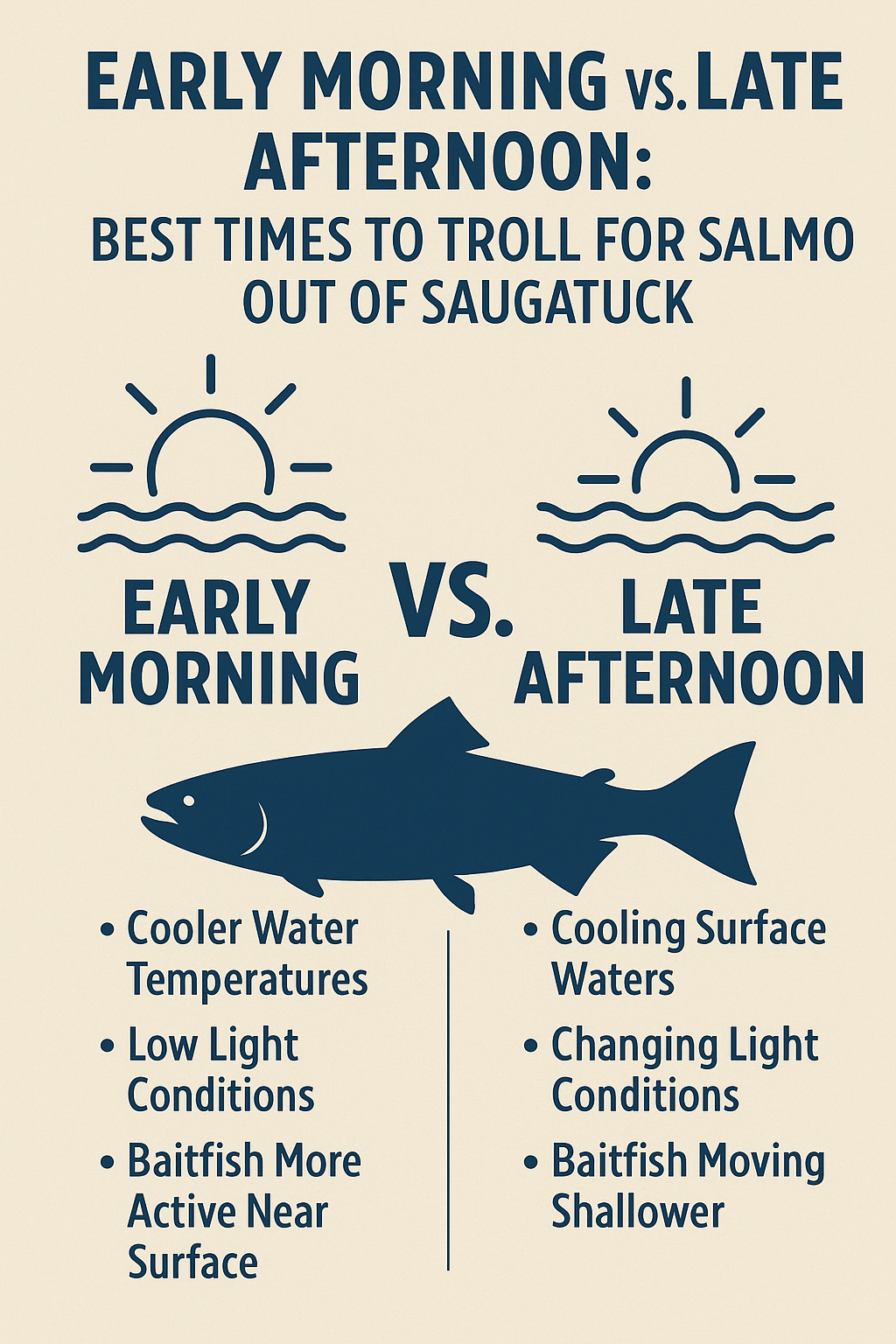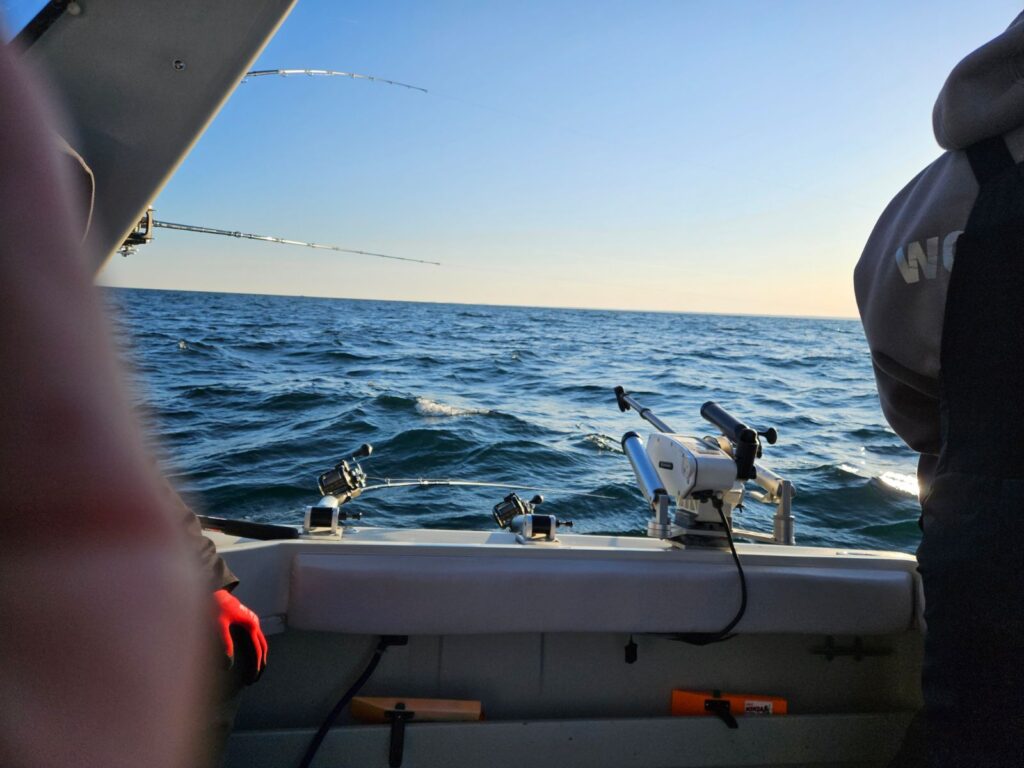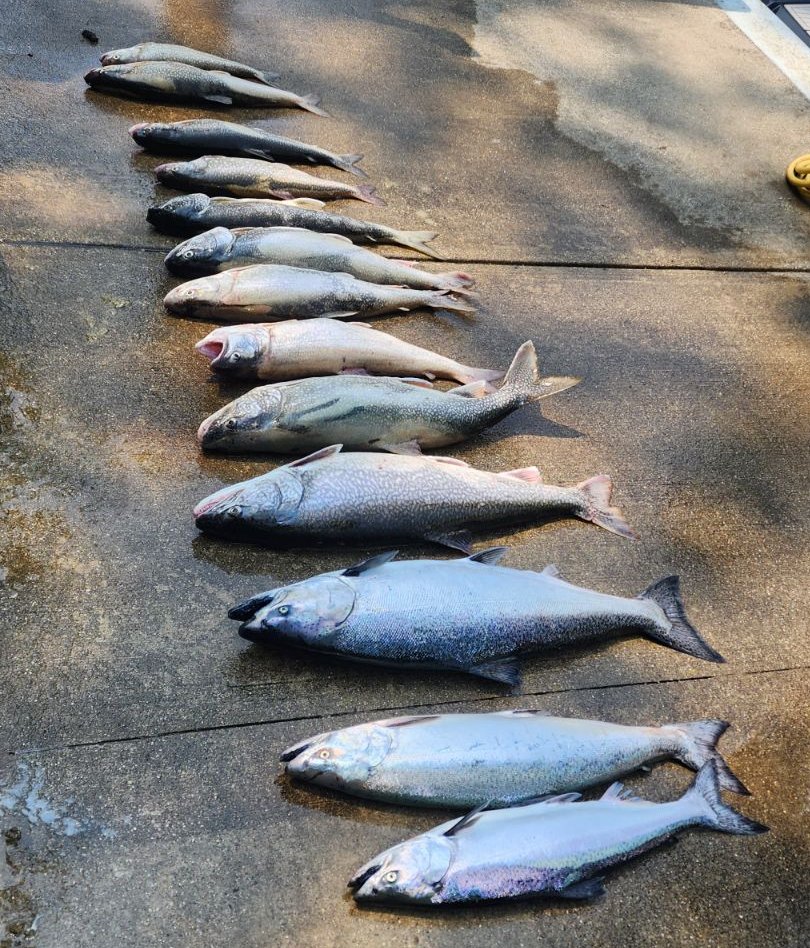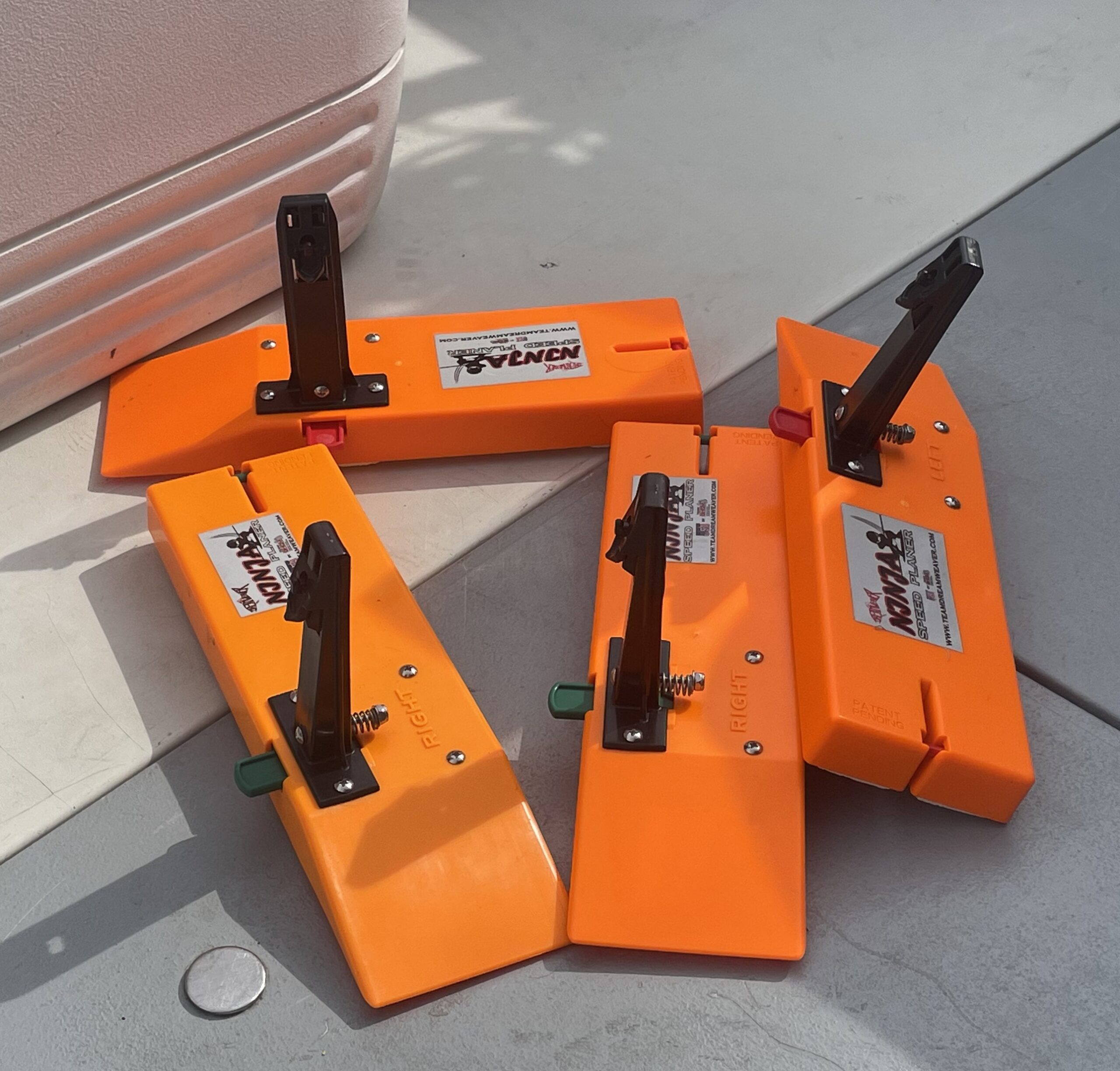If you’ve ever dreamed of landing a trophy salmon on the pristine waters of Lake Michigan, especially out of the charming port of Saugatuck, you know timing is everything. As a seasoned charter fisherman, I often get asked: When is the best time to troll for salmon—early morning or late afternoon? Both have their advantages and quirks, shaped by salmon feeding behavior, water temperature shifts, and the unique light conditions of Lake Michigan’s big waters.
In this post, I’ll break down the science and the experience behind these two prime fishing windows so you can decide the best time to plan your trip for peak success.
Understanding Salmon Feeding Behavior on Lake Michigan

Before we dive into the specific time-of-day details, it’s essential to understand the feeding patterns of the main salmon species we target here: Chinook (King) Salmon and Coho Salmon. Both species are opportunistic feeders that follow the movements of their prey—primarily alewives, smelt, and other baitfish.
Why Time of Day Matters
Salmon feeding activity is highly influenced by:
- Light conditions
- Water temperature
- Baitfish movement
These factors shift throughout the day, creating windows when salmon are actively hunting or resting.
Early Morning Trolling: The Dawn Advantage
What Makes Early Morning Special?
Early morning trolling, typically from sunrise until about 10 a.m., is a classic favorite among anglers for a good reason. The cool, low-light conditions at dawn trigger a natural feeding frenzy among salmon. Here’s why:
1. Cooler Water Temperatures
During the night, surface waters cool down significantly. As the sun rises, the water temperature starts to increase but often remains in the salmon’s preferred range of about 50 to 60°F during early morning hours.
Salmon are cold-water fish, and they thrive in cooler temperatures. Early morning waters offer the perfect comfort zone, which often makes salmon more active and willing to chase bait.
2. Low Light Conditions
The low-angle sunlight and dim lighting of dawn provide salmon with a stealth advantage. They use their excellent vision to ambush baitfish that are also more active near the surface during low light.
This contrast helps salmon feel more secure hunting near the top of the water column, which is why trolling with shallow-running lures or flashers during early morning can be incredibly productive.
3. Baitfish Activity
Many baitfish species follow a daily vertical migration pattern, moving toward the surface at dawn to feed on plankton and insects stirred up by the increasing light. Salmon track this movement closely.
Because the baitfish are near the surface and active, salmon follow, creating prime feeding opportunities.
Early Morning Trolling Tips for Salmon Out of Saugatuck
- Use shallow-running lures: Since salmon are feeding higher in the water column, use spoons, flasher-fly combos, or plugs set to run around 10-20 feet deep.
- Start trolling right at first light: The bite often heats up quickly at sunrise and can slow as the sun rises higher.
- Focus on the thermocline edge: Early morning is a great time to locate the thermocline (the temperature layer that separates warmer surface water from cooler deep water). Salmon often patrol the edges, so target those depth transitions.
- Keep your trolling speed steady: Around 2.0-2.5 mph is ideal to entice active salmon without spooking them.
Late Afternoon Trolling: The Evening Surge
Why Late Afternoon is Another Prime Time
Late afternoon fishing, roughly from 3 p.m. until sunset, offers another excellent window to troll for salmon. While the environment changes throughout the day, salmon often show a resurgence of feeding activity in these hours.
Here’s why:
1. Cooling Surface Waters
After the heat of midday, surface water temperatures begin to cool again in the late afternoon. This cooling effect often triggers salmon to move upward from the depths to feed actively once more.
2. Changing Light Conditions
Similar to early morning, the lower angle and softer light of the late afternoon create ideal conditions for salmon to hunt near the surface. The fading light reduces glare and improves salmon’s ability to spot baitfish, encouraging feeding behavior.
3. Baitfish Movement and Behavior
Baitfish, like alewives, tend to move shallower in the cooler, dimmer light, making them more vulnerable targets. Salmon take advantage of this predictable behavior, increasing their feeding activity.
Late Afternoon Trolling Tips for Salmon Out of Saugatuck
- Go deeper if water temps are warm: Salmon often adjust depth to stay within their preferred temperatures. Use downriggers or lead-core lines to get your lures down to 40-80 feet depending on the season and water temp.
- Switch up lure colors: As light fades, try bright or reflective lures that catch and reflect the ambient light to attract salmon.
- Adjust trolling speed: Slower trolling speeds (1.5-2.0 mph) can entice salmon during less active feeding periods.
- Look for structure: Salmon often patrol near drop-offs, humps, and underwater ledges during late afternoon. Use your GPS to mark these hotspots.
Comparing Early Morning and Late Afternoon: Which is Better?
The honest answer: both early morning and late afternoon can produce excellent results — but conditions and salmon behavior vary by season, weather, and lake conditions.
Here’s a breakdown of pros and cons for each time window to help you decide:
| Factor | Early Morning | Late Afternoon |
| Water Temperature | Cooler, more comfortable for salmon | Cooling after peak heat, good activity |
| Light Conditions | Low light, excellent for surface strikes | Low light, reflective lures work well |
| Salmon Feeding | Usually a strong feeding window | Often a second feeding surge |
| Baitfish Behavior | Near surface, active | Moving shallower again |
| Typical Depth | Shallow to mid-depth | Mid to deep depending on temps |
| Fishing Pressure | Lower, fewer boats early | Can be higher as more anglers join |
How Seasonal Changes Affect Your Best Time to Troll
The best time to troll can also shift with the season:
Spring and Early Summer (May – Early July)
- Water temps are generally cooler throughout the day.
- Salmon tend to feed actively during early morning and remain active longer into the afternoon.
- Early morning trips are often very productive as salmon adjust from cold winter depths.
Mid to Late Summer (July – August)
- Surface waters warm significantly during the day.
- Salmon often move deeper during midday and early afternoon to avoid warmer temperatures.
- Late afternoon can be better as the water cools down, bringing salmon back toward the surface.
- Early morning still offers good shallow feeding before the sun warms the lake.
Fall (September – October)
- Water temperatures start cooling overall.
- Salmon become more aggressive feeders, especially before their spawning runs.
- Both early morning and late afternoon fishing can be fantastic, with salmon chasing bait aggressively near the surface.
- Late afternoon trips may catch the “last bite” before nightfall.
What You Can Expect on Your Saugatuck Charter Trip
When you book a salmon trolling charter out of Saugatuck, here’s a taste of what you’ll experience during these prime fishing times:
Early Morning Experience
- Setting out before dawn: There’s something magical about pushing off from the dock as the sky lightens, the water still calm, and the world quiet except for the hum of the boat motor.
- Watching the sunrise over Lake Michigan: The early morning light plays off the waves, and the cool air feels refreshing.
- The thrill of first strikes: The bite often comes fast and furious in early morning—reels screaming, lines tightening as salmon chase your lures.
- Less boat traffic: Early risers tend to have the water more to themselves, which means less disturbance and better conditions.
Late Afternoon Experience
- Relaxed pace after a busy day: You’ll head out when the sun begins to lower, the lake breezes cool off, and the golden hour casts long shadows.
- Beautiful lighting for photos: The softer light of late afternoon is perfect for snapping pictures of your catch and the stunning lake scenery.
- Active fish returning to feed: Salmon are often aggressive in these hours, giving you a great shot at multiple bites.
- Social atmosphere: More boats may be out, so you can enjoy the camaraderie with other anglers while still focusing on fishing.
Final Recommendations: When to Hit the Water for Peak Success
If you’re looking to maximize your chances for a trophy salmon catch out of Saugatuck, here’s my advice:
- Choose early morning trips if:
- You prefer cooler temperatures and calm water
- You want to enjoy peaceful solitude on the lake
- You want to target salmon feeding near the surface
- You want to experience the iconic Lake Michigan sunrise
- Choose late afternoon trips if:
- You prefer milder temperatures after a warm day
- You want to take advantage of a second feeding surge
- You’re prepared to troll deeper and use varied lure techniques
- You enjoy the social vibe of a busier time on the water
Pro Tips for Both Times of Day
Regardless of when you choose to fish, these tips will help:
- Pay attention to weather and lake conditions: Wind, cloud cover, and barometric pressure can all affect salmon feeding times.
- Be flexible and ready to adjust: Salmon can be unpredictable, so changing trolling depths and speeds can make all the difference.
- Bring a variety of lures: Different colors and styles work better depending on light conditions and fish mood.
- Trust your guide’s experience: Local captains know the nuances of Lake Michigan’s salmon runs and will adjust tactics to give you the best shot.
Trolling for salmon out of Saugatuck on Lake Michigan is an unforgettable experience, and choosing the best time to fish can greatly increase your chances of success. Early mornings bring cooler water, low light, and active surface feeding, while late afternoons offer another prime feeding window as water cools and salmon resume their chase.
Whether you prefer the peaceful serenity of dawn or the dynamic energy of the evening bite, both times offer unique advantages and memorable fishing moments. When you join us on a charter trip, you’ll learn firsthand how to read the lake, interpret salmon behavior, and make the most of your time on the water.
So pack your gear, get ready for action, and let’s hit the water in Saugatuck—because salmon fishing here is about timing, technique, and a bit of Lake Michigan magic.
Tight lines!

 Lake Michigan is renowned for its thriving salmon fishery, attracting anglers from all over the world. One essential tool that has revolutionized salmon fishing on this majestic lake is the downrigger. This device allows you to precisely control the depth at which your bait or lure is presented, increasing your chances of landing a prized salmon. In this comprehensive guide, we will walk you through the step-by-step process of effectively using downriggers for salmon fishing on Lake Michigan.
Lake Michigan is renowned for its thriving salmon fishery, attracting anglers from all over the world. One essential tool that has revolutionized salmon fishing on this majestic lake is the downrigger. This device allows you to precisely control the depth at which your bait or lure is presented, increasing your chances of landing a prized salmon. In this comprehensive guide, we will walk you through the step-by-step process of effectively using downriggers for salmon fishing on Lake Michigan.
 When it comes to freshwater fishing, few experiences can rival the thrill of salmon fishing on Lake Michigan. The combination of picturesque landscapes, abundant salmon populations, and the strategic use of planer boards creates a perfect recipe for an exciting angling adventure. In this blog post, we will delve into the world of planer boards and uncover why they are a valuable tool for any salmon angler on Lake Michigan.
When it comes to freshwater fishing, few experiences can rival the thrill of salmon fishing on Lake Michigan. The combination of picturesque landscapes, abundant salmon populations, and the strategic use of planer boards creates a perfect recipe for an exciting angling adventure. In this blog post, we will delve into the world of planer boards and uncover why they are a valuable tool for any salmon angler on Lake Michigan.